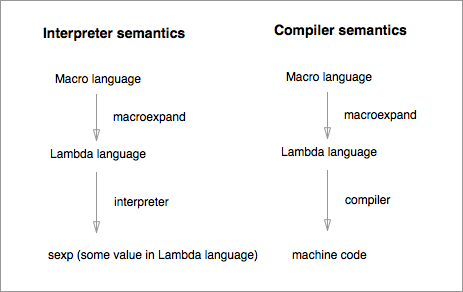Lisp with Macros is Two Languages
A Lisp with a macro system is actually two languages in a stack. The bottom language is the macro-less target language (which I'll call the Lambda language). It includes everything that can be interpreted or compiled directly.
The Macro language is a superset of the Lambda language. It has its own semantics, which is that Macro language code is recursively expanded into code of the Lambda language.
Why isn't this obvious at first glance? My take on it is that because the syntax of both languages is the same and the output of the Macro language is Lambda language code (instead of machine code), it is easy to see the Macro language as a feature of the Lisp. Macros in Lisp are stored in the dynamic environment (in a way similar to functions), are compiled just like functions in the Lisp language (also written in the Macro language) which makes it even easier to confuse the layers. It seems like a phase in some greater language which is the amalgam of the two.
However, it is very useful to see these as two languages in a stack. For
one, realizing that macroexpansion is an interpreter (called
macroexpand) means that we can apply all of our experience of
programming language design to this language. What useful additions can
be added? Also, it makes clear why macros typically are not first-class
values in Lisps: they are not part of the Lambda language, which is the
one in which values are defined.

The separation of these two languages reveals another subtlety: that the macro language is at once an interpreter and a compiler. The semantics of the Macro language are defined to always output Lambda language, whereas the Lambda language is defined as an interpreter (as in McCarthy's original Lisp paper) and the compiler is an optimization. We can say that the Macro language has translation semantics.
But what if we define a stack that only allows languages whose semantics are simply translation semantics? That is, at the bottom there is a language whose semantics define what machine code it translates to. We would never need to explicitly write a compiler for that language (it would be equivalent to the interpreter). This is what I am exploring now.